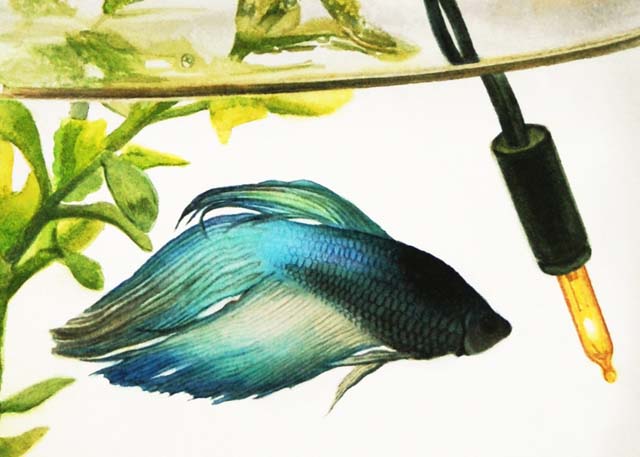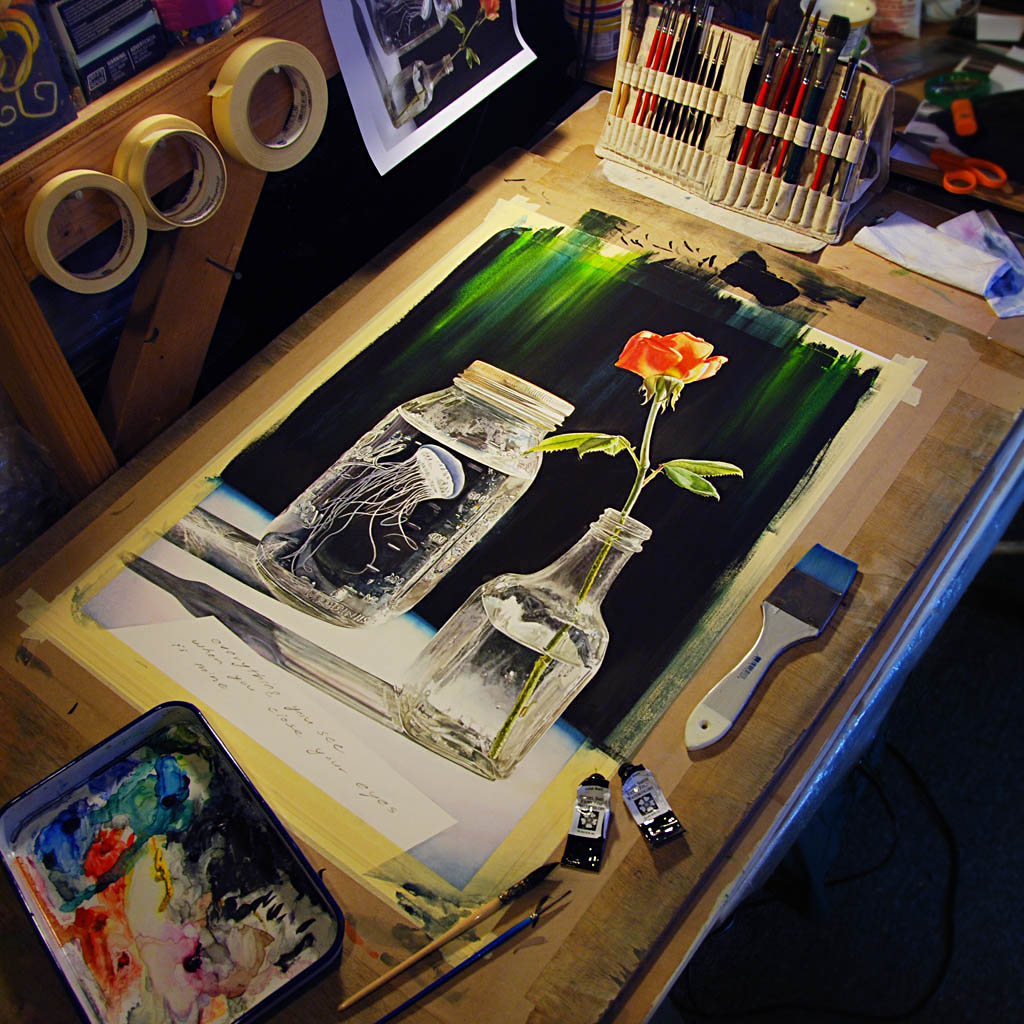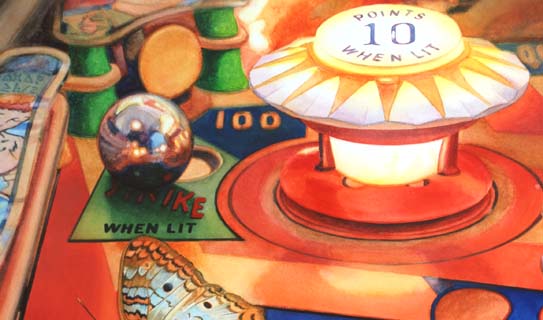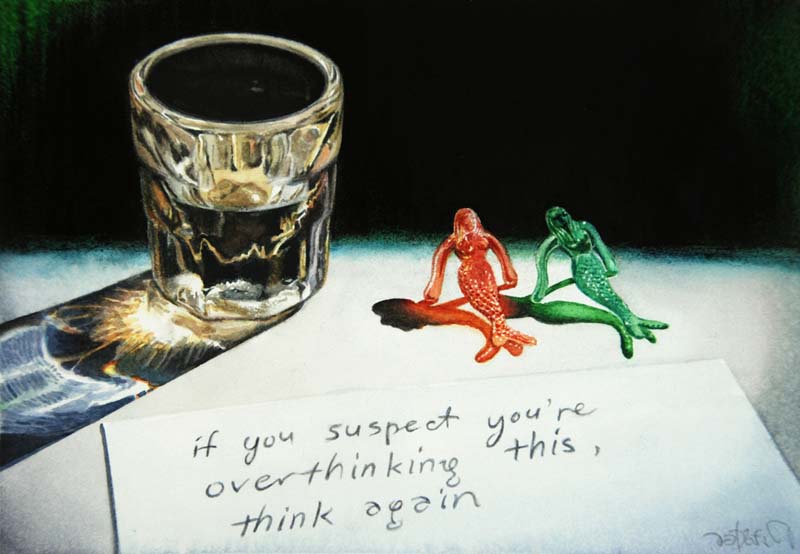Answers to common questions about the watercolorsWhich of your paintings are still available?You can see my available watercolors here. You can also browse and buy available paintings online at 1stdibs.com. Why do these paintings look so different from other watercolors? The short answer is that I use smooth paper and staining pigments. To learn more, consider this zoomed-in view of one my larger watercolor paintings (showing a 5x7-inch region)...  Buzz (detail view), 2013, watercolor on Arches hot press paper... Here you can see how smooth this paper really is. Note that the white color you see in the above image is just the unpainted paper showing through, and, as you can see, it is completely smooth. Most watercolor artists use textured paper and sedimentary colors, both of which create a characteristic granulation pattern -- this is a classic watercolor effect. But my preference is to use hot-press watercolor paper, which has a very smooth surface, and staining colors, the fine-grained pigments of which tend not to produce any noticeable textures, as you can see above. Staining pigments also help create much sharper contrasts than you normally see in watercolor paintings. The one sedimentary color I use is a black pigment (iron oxide) -- this is also relatively uncommon. Because of these differences, people are often surprised when seeing my work for the first time to learn that they are in fact watercolors. How can I get updates about your newest work? The very best way to hear about new work these days is to follow me on Instagram or on TikTok, or subscribe on YouTube. There you can see new works in progress from the very early stages. Why are the edges of your paintings so sharp and crisp? The borders of each painting are masked with drafting tape at the beginning of the process. This produces a sharp edge when the tape is removed, although occasionally there is a slight seepage, which adds a little extra handmade character.  Dreamcatcher on the drawing board. Despite the overpainted edges, the drafting tape along the edges will ensure a crisp border when it is removed. Don't watercolor paintings inevitably fade over time? Not so much these days. It's true that watercolor paints in previous centuries were often made from vegetable dyes and other natural materials that were prone to fading when exposed to strong light. Some artists still use these "old master" colors out of respect for tradition. But I use only the most permanent modern pigments such as phthalocyanine blue and green, quinacridone magenta, and benzimidazolone yellow. These have the very best light-fastness ratings and should last for many centuries. Properly cared for, my watercolors are at least as archival as oil paintings. You should still keep them out of direct sunlight, which can damage any artwork. How should I care for an original watercolor painting? My paintings can be enjoyed by many generations if you observe a few simple precautions. Keep them framed under glass or plex, with archival matting and backing board, and hang them (and any other artworks) away from direct sunlight, moisture, and smoke or other atmospheric pollutants. Severe fluctuations in temperature and humidity can also be detrimental to any artwork, so interior walls are usually better than poorly insulated exterior walls. Select your hanging location with care to ensure the longevity of your collection. Do you paint from photos? Mainly yes. Many of my subjects are insects, which are not cooperative when it comes to standing still for long periods. I am also interested in the documentary character of photographic images, even when the images are obviously fictional. My images are narrative, and the story becomes more believable when the images have some photographic qualities. Do you use opaque pigments? As a rule, no. The white you see in the highlights and reflections is the natural color of the unpainted paper. I believe the greatest clarity in watercolor is achieved by the use of transparent pigments and by letting the white of the paper show through.  Tilt (detail view), watercolor, 2010. The pure white you see in this and other watercolors is just the unpainted paper Where do you get your subjects? A surprising number of them fly in the open door of my studio. Some of the native butterflies and moths I raised from caterpillars in my studio. Others I have photographed in the wild or at the Long Beach Aquarium or at the Los Angeles Natural History Museum. Some of the more exotic creatures I first draw digitally before rendering them in watercolor. Despite some of the precarious situations I depict in my art work, none of my living subjects are ever in danger, and all wild subjects are released unharmed after a photo session. I collected the pinned insects as a science project way back when I was a teenager. What kind of paints/brushes/paper do you use? Many people are surprised to learn that I normally use just a half dozen colors, typically phthalocyanine blue, phthalocyanine green, quinacridone magenta, benzimidazolone yellow, Payne's gray, and lunar black. In a few recent paintings, such as "Tilt" (detail above), I also used cadmium red, but it's not yet a regular item in my paintbox. Why work with such a limited range? I find that such a simple palette allows me to get to know the handling characteristics of each paint quite intimately. Some artists with more prodigious memory powers might be able to recall and predict the unique behaviors of twenty or more different pigments and their possible combinations, but for me six is about the limit. I prefer Winsor & Newton paints (or Daniel Smith, in the case of lunar black), always in tube form. I paint on sheets of Arches hot-press watercolor paper stretched onto a plywood backing board. I have only a few small sable brushes for details -- more often I use large squirrel quills and cheap student brushes. You can see demonstrations of my painting methods on various social media sites, if you are curious to learn more about the nuts and bolts of the process. Why do you sign your work backwards? I wrote backwards all the time when I was younger... As a left-hander it just felt more natural. When I started incorporating text into my paintings years ago, I began signing the work using my childhood backward script so that the signature wouldn’t compete with the text as a visual element to be read. Each painting is also signed on the back.  Overthinking, 2014, watercolor. My normal signature (lower right) is backwards so it doesn't compete with the painted text (center). How long does it take you to complete a painting? I normally spend anywhere from three weeks to three months completing a watercolor painting. Occasionally, a complex or difficult subject will take longer, sometimes a year or more. Shooting and editing the photographs that I use as source images can also add days or sometimes weeks to the overall process. Are you the same Paul Pitsker I knew way back when? Yes. Do you sell prints of your work? Yes, you can now buy unlimited edition prints of select watercolors at fineartamerica.com. What if I have another question? Please feel free to contact me directly. And thanks for reading this far! CONTACT INFO
Other links |

|



|
|
|





